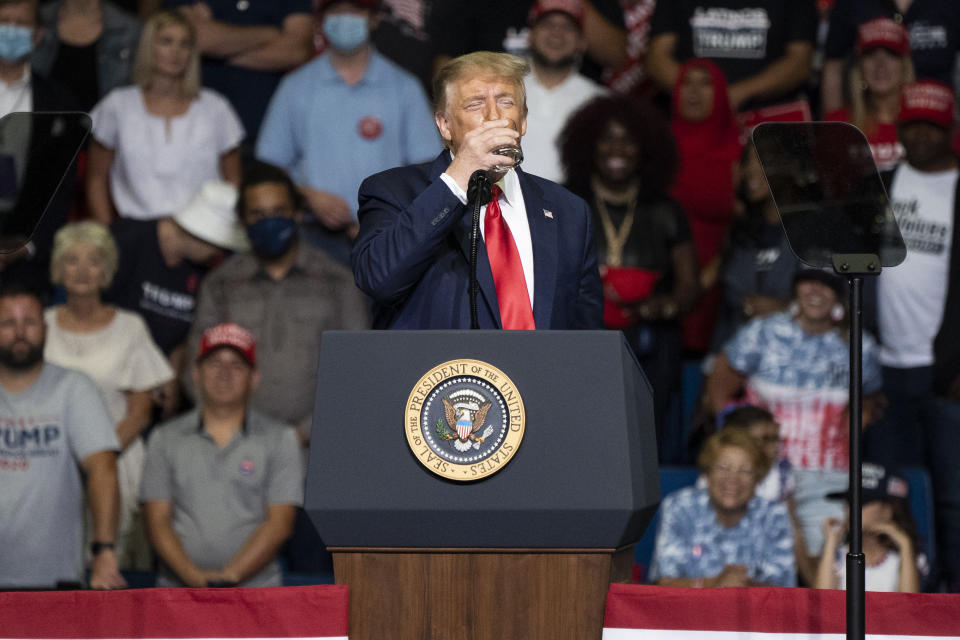The Lincoln Project's 'Never Trump' ads expertly troll a president who never fails to take the bait
WASHINGTON — A political campaign built around making videos designed to bait the president of the United States into overreacting would almost certainly have been a total waste of time at any other moment under any other commander in chief.
But Donald Trump is unlike any other president.
And so for the Lincoln Project, which was created by a group of anti-Trump Republican political operatives last December, that means there is a logic to being a metaphorical fly buzzing around the president’s head.
“If he responds, we know we’ve had some effectiveness,” Reed Galen, a co-founder of the Lincoln Project, told Yahoo News. “It’s not just a matter of trolling him. That’s fine, but that’s not the point. The point is to throw him off his game politically, strategically, personally.”

Even the group’s name, evoking the Republican president whom Trump likes to compare himself to (generally favorably), seems intended to get a rise out of the president.
The trolling, in other words, is aimed at pushing Trump to further demonstrate to swing voters why they should vote against him. That’s a relatively new method for influencing swing voters.
Voter persuasion has traditionally been done through advertisements, and for a long time the most effective way to get an ad in front of a voter was to pay a TV network to air it.
Over time, earned media also became an option. Do something that gets attention, whether through a provocative ad or something else, and it will get noticed and talked about on cable TV, on the internet and then among voters.
But usually political ads are aimed at getting the attention of voters, either directly through a paid ad or indirectly through starting a conversation in the media.
Trump is the first president who watches hours of cable TV a day, who spends large amounts of time on Twitter and who is easily drawn into petty spats.
Any other president would have laughed off jokes about his age and physical fitness after walking slowly down a ramp, as Trump did following his speech to graduating West Point cadets on June 13.
But as social media obsessed about Trump’s cautious stroll, the Lincoln Project’s Twitter handle started using the hashtag #Trumpisnotwell. The top operatives who are part of the Lincoln Project, who collectively have over 3 million Twitter followers, amplified the hashtag.
Three days later, the group released an ad titled “#TrumpisNotWell.” It began with a shot of Trump drinking water with two hands, another subject of social media fascination, and then showed him walking down the ramp. “Something’s wrong with Donald Trump. He’s shaky. Weak. Trouble speaking. Trouble walking,” the narrator said over spooky music. “The most powerful office in the world needs more than a weak, unfit, shaky president. Trump doesn’t have the strength to lead.”

That video has been viewed 1.3 million times on Twitter. Many of the project’s videos now regularly hit more than 1 million views.
But so what? Which voters who might vote for Trump are going to change their minds based on that ad? And more important, how many persuadable voters are actually taking the time to watch political videos on YouTube?
Most persuadable voters are not paying much attention at all to politics, especially during the summer, said Austin Barbour, a Republican operative who has worked on multiple presidential campaigns.
“I’m not convinced they’ll actually move any voters because they may not have enough cash to reach real swing voters in an impactful way,” Barbour told Yahoo News. He did pay the group a compliment for the edginess of their videos. “If they do have the cash, their ads are good,” he said.
Barbour also said that the group has “somewhat made this about them and their hate of Trump.”
“If they don’t reach real voters,” Barbour said, “this is just a glamour project for some associated with the group.”
However, when Trump held a rally in Tulsa, Okla., on June 20, he spent several minutes talking about his walk down the ramp, explaining to the crowd what had happened, and why he drinks water with two hands.
“I don’t want to get water on the tie, and I don’t want to drink much, so I lift it up, the water,” Trump said. “I have lived with more the ramp than the water, but I have lived with the ramp and the water since I left West Point.”

Galen also said that the Lincoln Project began running a video about the Confederate flag on May 31, weeks before Trump began to wade into various controversies around race and racism. On July 6, for example, the president criticized NASCAR for banning the Confederate flag from its events.
“It’s exactly the kind of box canyon you want him to go into,” Galen said.
On July 1, a few days before that, Trump said that painting “Black Lives Matter” on Fifth Avenue in New York would be a “symbol of hate.”
The word “weak” is one of the Lincoln Project’s favorite adjectives for Trump, who often boasts about his strength and loves to be photographed with military officers and gear. The ads have clearly gotten under Trump’s skin. In early May he went after the group on Twitter and mentioned each of its leaders by name: Galen, Rick Wilson, John Weaver, Steve Schmidt, Jennifer Horn and George Conway, a conservative attorney who is married to one of Trump’s top political advisers, Kellyanne Conway.
That kind of attention from the president only helps elevate the group, swelling its email list and adding to its fundraising. And that could help it run targeted TV and digital ads in key swing states closer to the election. So far, it’s spent just under $3 million on paid TV ads and $1.2 million on Facebook ads.
Galen, when asked what other president would have even responded to any of this in the past, answered simply: “None.”
_____
Read more from Yahoo News:



